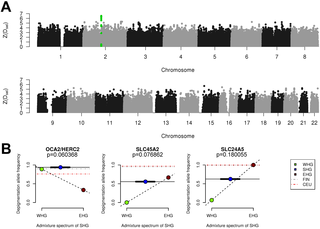PLOS Biology ( IF 9.8 ) Pub Date : 2018-01-09 , DOI: 10.1371/journal.pbio.2003703 Torsten Günther , Helena Malmström , Emma M. Svensson , Ayça Omrak , Federico Sánchez-Quinto , Gülşah M. Kılınç , Maja Krzewińska , Gunilla Eriksson , Magdalena Fraser , Hanna Edlund , Arielle R. Munters , Alexandra Coutinho , Luciana G. Simões , Mário Vicente , Anders Sjölander , Berit Jansen Sellevold , Roger Jørgensen , Peter Claes , Mark D. Shriver , Cristina Valdiosera , Mihai G. Netea , Jan Apel , Kerstin Lidén , Birgitte Skar , Jan Storå , Anders Götherström , Mattias Jakobsson

|
Scandinavia was one of the last geographic areas in Europe to become habitable for humans after the Last Glacial Maximum (LGM). However, the routes and genetic composition of these postglacial migrants remain unclear. We sequenced the genomes, up to 57× coverage, of seven hunter-gatherers excavated across Scandinavia and dated from 9,500–6,000 years before present (BP). Surprisingly, among the Scandinavian Mesolithic individuals, the genetic data display an east–west genetic gradient that opposes the pattern seen in other parts of Mesolithic Europe. Our results suggest two different early postglacial migrations into Scandinavia: initially from the south, and later, from the northeast. The latter followed the ice-free Norwegian north Atlantic coast, along which novel and advanced pressure-blade stone-tool techniques may have spread. These two groups met and mixed in Scandinavia, creating a genetically diverse population, which shows patterns of genetic adaptation to high latitude environments. These potential adaptations include high frequencies of low pigmentation variants and a gene region associated with physical performance, which shows strong continuity into modern-day northern Europeans.
中文翻译:

中石器时代的斯堪的纳维亚半岛的人口基因组学:研究冰川后的早期迁徙路线和高纬度适应
斯堪的纳维亚半岛是“最后冰川高峰”(LGM)之后欧洲最后一个可供人类居住的地理区域之一。但是,这些冰川后移民的途径和遗传组成仍不清楚。我们对斯堪的纳维亚半岛发掘的7个狩猎采集者的基因组进行了测序,覆盖率高达57倍,采集日期为目前的9500-6000年(BP)。令人惊讶的是,在斯堪的纳维亚中石器时代的个体中,遗传数据显示出东西方的遗传梯度,与在中石器时代的欧洲其他地区所看到的模式相反。我们的研究结果表明,两次冰川后早期迁移到斯堪的纳维亚半岛:最初是从南部,后来是从东北。后者沿无冰的挪威北大西洋沿岸航行,新的和先进的压力刀片石工技术可能沿此传播。这两个群体在斯堪的纳维亚半岛相遇并混合在一起,形成了遗传多样性的种群,显示了遗传适应高纬度环境的模式。这些潜在的适应性变化包括高频率的低色素沉着变体和与体能相关的基因区域,显示出在现代北欧人中的强连续性。



























 京公网安备 11010802027423号
京公网安备 11010802027423号